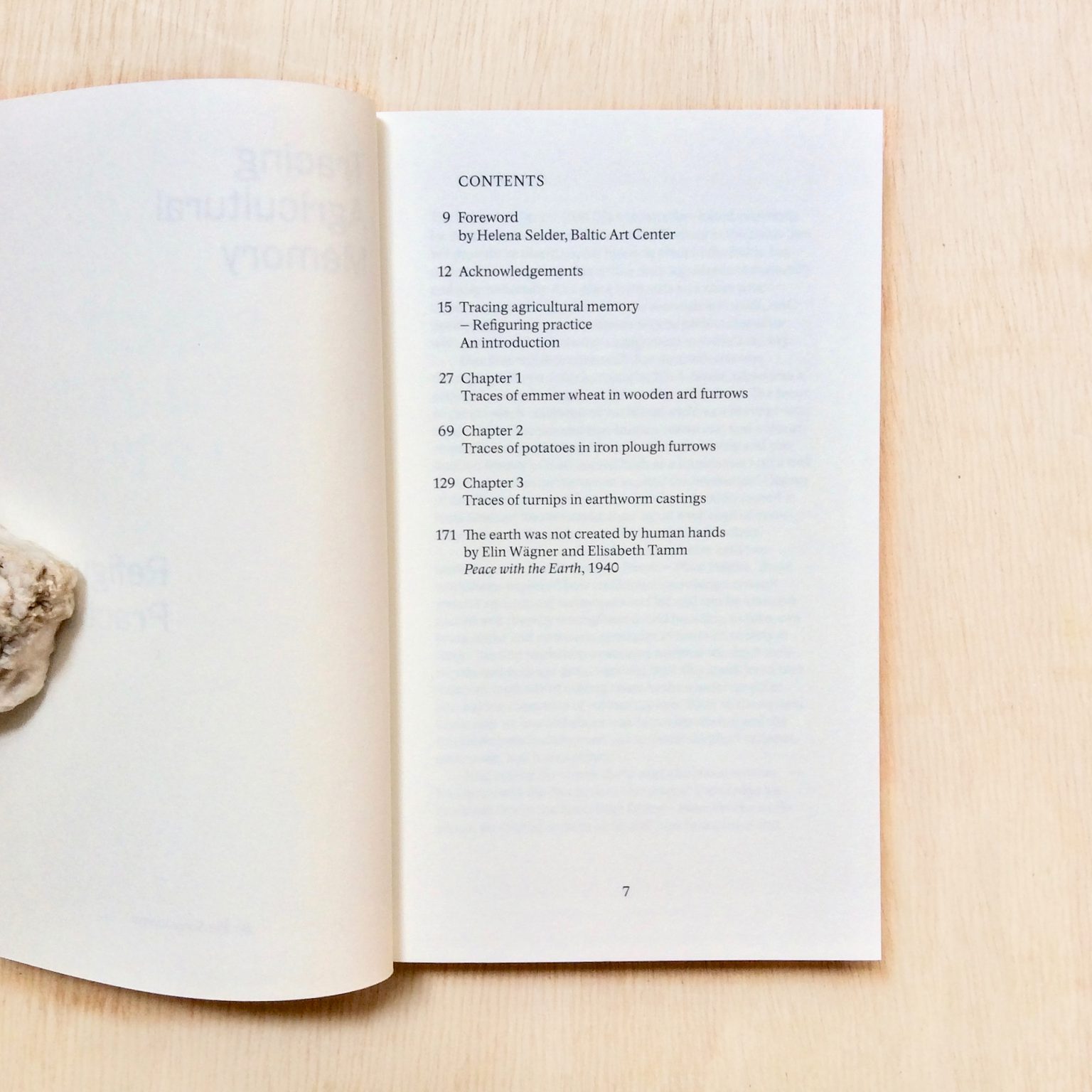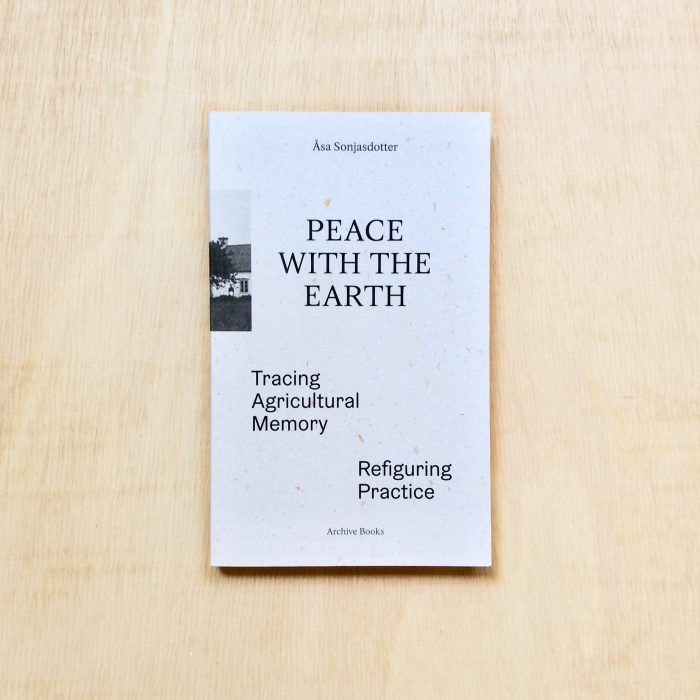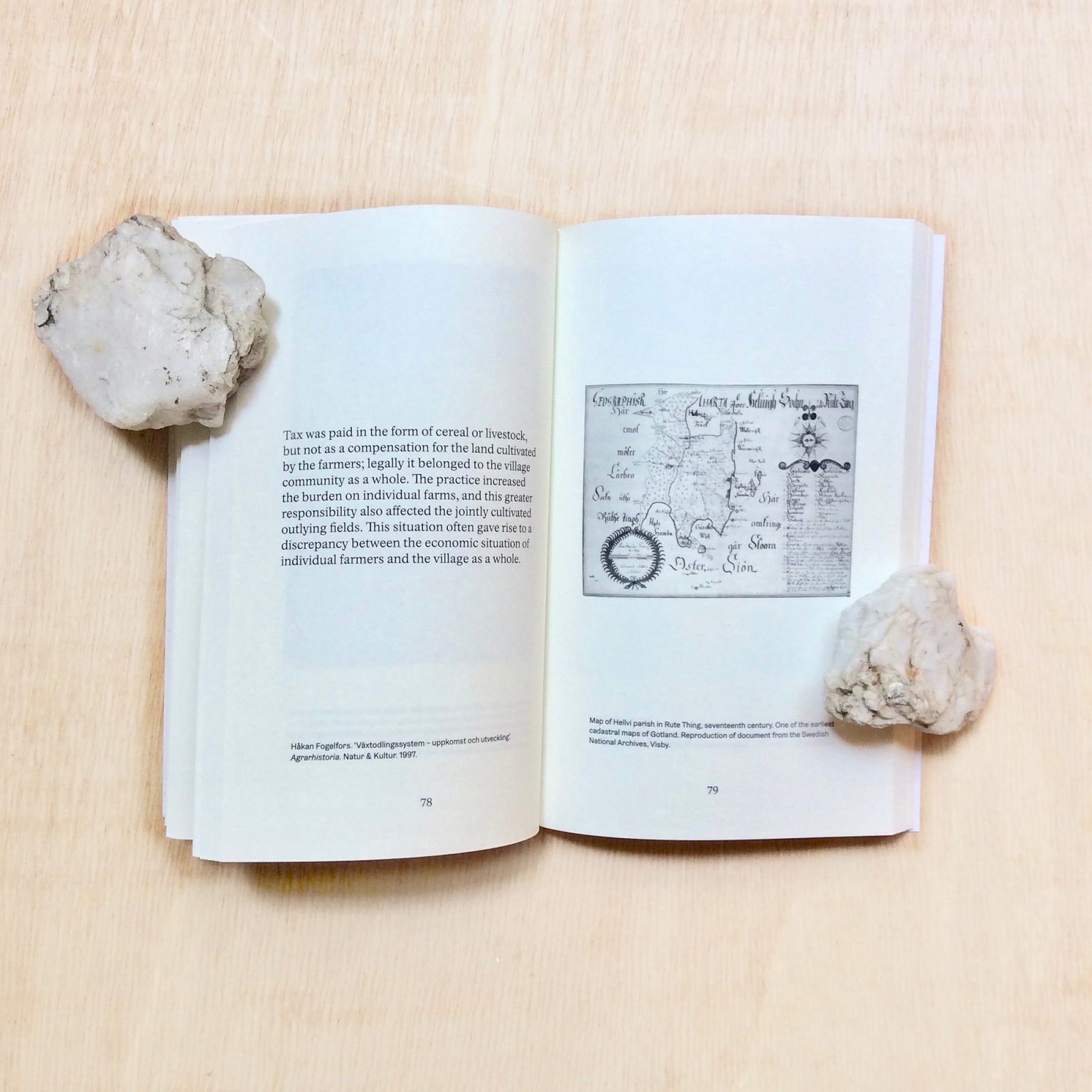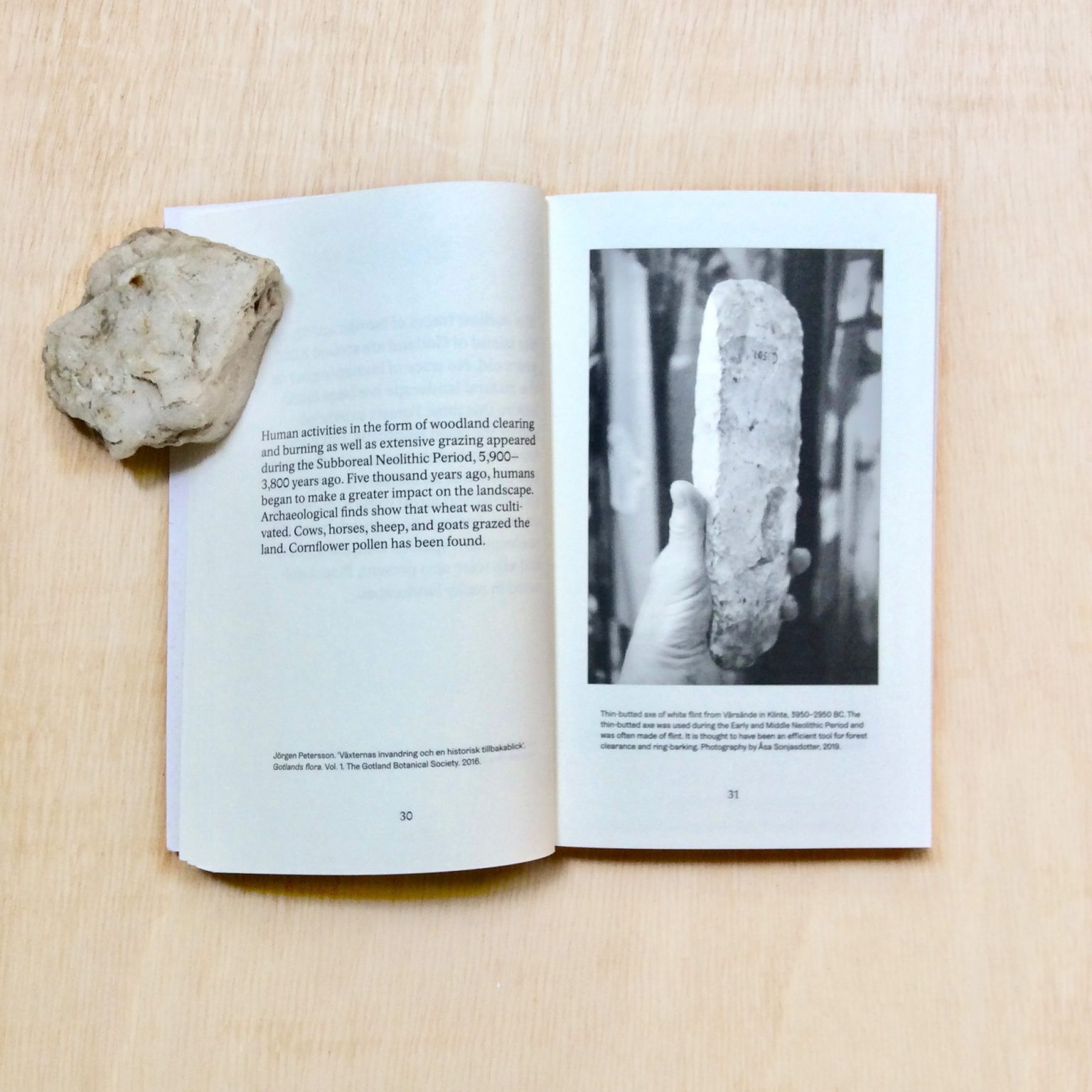Peace with the Earth
Tracing Agricultural Memory
– Refiguring Practice
By Åsa Sonjasdotter
Edited by Ros Gray
Published by Archive Books in 2019
The artistic, micro-historical enquiry presented in this book responds to the call, made by two Swedish suffragettes and peace activists Elisabeth Tamm (1880–1958) and Elin Wägner (1882–1949) in their pamphlet Fred med Jorden (Peace with the Earth, 1940).
Grounded in research into agricultural practices on the Swedish island of Gotland in the Baltic Sea, the quotations, documents and photographs of dead and living matter presented in the book, testify to ways of living off the land prior, during and after land-reforms and industrialisation processes. The assemblages sketch out the nurturing environments of three relict crops cultivated from prehistoric times until the present day.
The research presented, reveals inconsistencies in historical narratives regarding the ‘progress’ of modern agriculture. From these cracks and gaps, possibilities for cultivation systems that nurture the soil and its habitat are opened up, enabling humans to actually live in peace with the Earth.




Graphic design by Konst & Teknik
Translation from Swedish to English
by Katarina Trodden and Kathy Gow Sjöblom
English
176 pages
ISBN 978-3-948212-17-9
Tracing agricultural memory
– Refiguring practice
An introduction by Åsa Sonjasdotter:
The quotations, documents, photographs, and dead and living matter presented in the following chapters testify to ways of living off the land. These objects raise questions about the methods humans use to feed themselves. Built as assemblages, the chapters sketch out scenarios of stories that are not entirely filled out. Instead, they offer possibilities for various readings and re-readings. The objects function as buoys in a large spacetime, creating potential routes to further knowledge.
Most of these materials were found on Gotland, an island located in the Baltic Sea in southeast Scandinavia. Because of its location in the middle of a large body of water, things have happened at a different pace here compared to the mainland. Due to its distant location and different pace, Gotland’s inhabitants are not quick to dismiss unfashionable knowledge. This makes it a good place to search for traces in time.
The farming regions of southern Scandinavia, to which Gotland both belongs and is separate from, are home to several inventions that have come to dominate modern agriculture. One such invention is the harnessing of airborne nitrogen for the production of synthetic fertiliser. Another is the systematisation of ‘pure-line’ plant breeding, which has led to the cloned monoculture farming landscapes that continue to spread across the world. The Swedish Seed Association (Sveriges utsädesförening), later Svalöv AB, was one of the earliest industrial producers of standardised seeds in Europe. It was incorporated into the German BASF, which is now the world’s largest chemical manufacturer. The global company Yara, previously Norsk Hydro, was the first corporation to produce synthetic fertiliser.
I grew up in this epicentre of agribusiness expansion – partially on a smaller island called Ven, near the coastline – and experienced at close hand how it affected the people and the land. When machinery and production were scaled up after the Second World War, many smallholdings were dissolved and their land was incorporated into larger farms. As deeper ploughs merged and levelled the fields, older knowledge, vocabularies, and social webs were literally wiped out, making farmers vulnerable to the profit-driven system of agribusiness.
The title of the project Peace with the Earth refers to a pamphlet published by two Swedish suffragettes and peace activists in 1940, six months after the eruption of the Second World War. Elisabeth Tamm (1880–1958) served as one of the first women in parliament and was an organic farmer. Elin Wägner (1882–1949) worked as a writer and activist on matters of women’s rights, peace, and ecology, and was a member of the Swedish Academy. The observations and proposals in the pamphlet were based on ‘long and applied experience of traditional and modern agricultural practices and their effect on the land, livestock, and, ultimately, humans.’ Tamm and Wägner’s sharp analysis of industrial farming predicted many of the issues that have become apparent today, including soil erosion, water scarcity, as well as food and stress related health issues.
The findings of my research at the Museum of Gotland made me recall Tamm and Wägner’s pamphlet, which I stumbled upon in a public library many years ago. It’s not immediately easy to pin down the position from which the authors speak. Tamm and Wägner assert the importance of the role of women, whose rights are dismissed in society. However, their critique cannot be narrowed down to essentialist categories. Their discussion of patriarchy is complex, comprehensive, and includes spheres that extend beyond the category of the human. Writing at the outbreak of the Second World War, Tamm and Wägner state that ‘peace on Earth and a new and peaceful relationship with the Earth are inseparable.’ The authors come to the conclusion that ‘it is not possible to work on separate solutions to problems associated with peace, land distribution, healthcare, the population, or education. Each must be considered in relation to humankind’s affinity with the Earth; with life and the world around us. This involves a paradigm shift and all that it entails in terms of social change.’
At the time of its publication, Tamm and Wägner’s pamphlet was, for the most part, perceived as retrogressive. Today it is clear that the authors’ critique was correct. Industrial agriculture has become one of the major sources for climate collapse, species extinction, and epidemic illnesses. The question of how to live off the land has become an issue everyone must grapple with, whether they like it or not. Located between traditional and modern knowledge, Tamm and Wägner’s analysis offers a compass. The introductory chapter of Peace with the Earth is presented at the end of this publication. An English version of the entire pamphlet will be published by Archive Books in the coming year.
*
When researching the deeper history of agriculture in northern Europe, one soon becomes aware of the spacetime horizon that emerged with the retraction of the ice sheet that had covered the northern part of the globe for almost 100,000 years. In Europe, the sheet extended from the Arctic to southern Ireland, Great Britain, Scandinavia, Finland, northwest Russia, and northern Germany. When the ice began to recede some 10,000 to 13,000 years ago, species from neighbouring regions were able to migrate into the landscape that was laid bare. This major event set a spacetime horizon for the life that would re-emerge here. It is distinct from the surrounding landscape, whose accumulated soil memory – both non-cultivated and cultivated – runs far deeper.
Chapter one of this book, Traces of emmer wheat in wooden ard furrows, begins with a description of 6,000-year-old remains of grazing and woodland clearing: the first traces of human impact on nature after the ice receded. Trees were cut down and burnt to make space for arable land in the large forests that thrived in the rich red soil that had accumulated since the land was re-inhabited. This chapter presents a story of emmer wheat, which is among the first known crops to be grown on Gotland. Both the plant and the method for its cultivation came to the island during the Early Neolithic Period (3900–3300 BCE). The cultivation of emmer had migrated through Europe from Mesopotamia, where it had been domesticated about 7,000 years earlier. The grain has remained in cultivation until the present day, which is unique in Scandinavia. This early form of agriculture would, however, slowly deplete the soil. When the climate grew colder and wetter around 3500 BCE, soil depletion was rendered irreversible. In areas that had been exposed to farming, red soils were permanently lost. Previously thriving hardwood forests of oak, elm, alder, lime, and ash were replaced with the less nutrient-demanding beech, a forest that is still characteristic for the region.
*
Archaeological findings indicate that farming was re-estab- lished around permanent settlements surrounded by enclos- ed inner fields for cultivation and open outer fields and forests for cattle grazing. This method of farming, in place by about 1000–500 BCE, would prove to be extremely durable, lasting almost 1,000 years. It may have continued much longer had it not been for the extensive and continuous extraction of organic matter in the form of in-kind taxations that farmers had to pay to landlords, the Church, and the Crown. Records in real estate registers show that taxes were directly or indirectly taken from the harvest of the land and commonly consisted of grain, butter, or dried meat; goods that were relatively easy to store. Remnants of the transformations caused by this systematised extraction are presented in chapter two, Traces of potatoes in iron plough furrows.
Sweden’s first land taxation law was passed in 1350. Taxes increased as the state apparatus expanded. In times of war, extra taxes were often added as in-kind levies to warlords and soldiers. In the mid-1600s, the soil in farmers’ cowsheds was declared krono regale, a property belonging solely to the Crown. Special staff travelled to farms around the country and collected the urine-saturated soil, from which saltpetre, a core ingredient in gunpowder, was boiled. Archived lists of Royal tax income from saltpetre extractors registered in Gotland bear witness to this practice. Extraction for the establishment of the state apparatus and the army brought about what political theorist Karl Marx described as the primitive accumulation of capital: a redistribution of surplus to society’s powerful classes. This was taken not only from farmers, but from entire farming habitats. It came to cause irreversible damage to the ecosystems’ nutrient flows, which Marx described as an irreparable rift.
Over centuries, farm fields and surrounding grasslands became depleted. In the 1800s, this led to a collapse of the ecosystem and to social revolt. In central Europe, the breakdown occurred several centuries earlier. Feminist scholar Silvia Federici suggests that the many peasant uprisings in Europe in the 1600s can be understood as protests by farmers who experienced how the ongoing, accelerated extraction of farmland habitats destroyed their capacity to support the forms of life that had evolved there. Soil depletion became a much-debated topic in central Europe, Ireland, and the United Kingdom in the 1800s. The ‘remedy’ that was implemented did not, however, lead to a halt in extraction. Instead, it had the opposite effect. The response to the crisis involved the introduction of new technologies such as the invention of an iron plough that could cut deeper trenches into the soil and turn the furrows. This made it possible to open new land to farming. Meadows, moorland habitats, and other meagre soils were subsequently submitted to the iron plough.
The collapse of the European eco-social system escalated the appropriation of land for farming. This included the establishment of plantations on overseas continents. The emergence of potatoes in Europe bears witness to this. The plant came from the Americas in the 1600s, brought as food on the ships of the Atlantic triangular trade. Samples of tubers slowly spread throughout Europe. The early strains that reached Gotland by the mid-1900s are still maintained in gardens and plots, handed down among neighbours and within families. The new crop was often grown on reclaimed land, as it was not yet included in the rotation system and could be cultivated in less fertile soil. In Sweden, land reclamation was combined with the introduction of reforms. Farming villages that had previously held the juridical status of a collectively represented legal body in custody of shared land were transformed into clusters of individual property owners. Land was reorganised for each farmer, who became the singular owner of a strictly mapped and measured portion of the land to which the farm buildings were relocated.
*
There is, however, a part of the history of cultivation in this region that is poorly documented, but has, in recent years, gained increased attention from historians and archaeologists. Chapter three, Traces of turnips in earthworm castings, deals with the role of kitchen gardening in the farming system. In a recent survey of early cadastral maps made in Sweden, agricultural historian Karin Hallgren discusses evidence that kitchen gardening was common and extensive among farmers, especially before the land reforms. In her study, Hallgren surveys historical books on the topic and assembles details that shed light on various practices and approaches.
Many different names were used for the kitchen garden in primary sources. It was called the kale patch, kale garden, kale bed, kale field, herb patch, or herb garden. Cultivars belonging to the Brassica family, such as cabbages, turnips, broccoli, oilseed rape, and mustard, were common plants, although a much larger variety of vegetables were grown. In 1723, the Swedish botanist Carl Linnaeus listed almost one hundred different vegetables and herbs grown in his parents’ freehold garden, a number that resembles other sources. It is believed that many garden plants were introduced to Scandinavia from southern Europe through the monasteries that were established beginning in the 1200s. However, details regarding how this transfer occurred have only recently become a topic of research. In a diary from a journey to Gotland in 1741, Linnaeus describes the gentle taste of a local turnip that he names Napum sylvestrem.The third chapter tells the story of this special Gotland turnip, which, in spite of its fame, was abandoned and rendered extinct with the expansion of the sugar- and fodder beet industry.
Vegetables don’t store as well as grains, which makes them a less desirable currency for overseas trade. This might explain why kitchen gardens remained unregulated and undocumented by authorities although they were a prime source of food for farming families – especially since much of the grain harvests were used to pay taxes. Several sources indicate that women and children were responsible for the maintenance of the kitchen garden. This might be another reason why scholars in a patriarchal society have overlooked this aspect of the farm system. The Museum of Gotland’s large photographic archive represents several pre-industrial farming tasks. The few images that document kitchen gardens are presented in this chapter; however, you have to look very carefully to spot the women and children in the photographs. One of the small number of Swedish paintings depicting labour in the kitchen garden is also presented here. It shows two people planting kale seedlings in the spring.
Access to fertiliser is a crucial aspect of any cultivation system, and cabbage varieties require especially rich soil.How, then, were these kitchen gardens fertilised? Documentation has shown that in the pre-chemical farm system, much of the grain yield was dependent on cattle manure. Some of the historical sources researched by Hallgren provide clues regarding the fertilisation and productivity of kitchen gardens. According to a 1671 note by Johan Risingh, Secretary of the Commercial College of Sweden, manure from dogs, humans, and birds – both wild and domesticated – was considered suitable for the cabbage patch. Carl Carleson, a judge and Member of Parliament, recommended fertilising kitchen gardens with the contents of the latrine. In 1756, he wrote that human excrement was ‘the most powerful of fertilisers’ and that a good housekeeper should ensure that such ‘wonderful balm’ did not go to waste. It possessed a ‘fatty’ quality, he argued, that was effective for both cabbages and herbs. Risingh also stated that a well-tended cabbage patch could yield more food than ten fields of cereals equivalent in size.
Unfortunately, there is poor documentation of how common it actually was to use human waste in plant cultivation. A study by antiquarian Gun Westholm of the medieval sewage system in the town of Visby on Gotland reveals that human waste was not returned to the land but was, instead, piped directly into the ocean. Although farmers must have returned their waste to the land some way or other, the general failure to employ human manure seems to be a fatal error. Considering the consequences of soil depletion throughout history, it is astounding that people have neglected to take advantage of the rich and nourishing matter that is produced by their own bodies.
Returning composted manure to the soil contributes to a soil habitat in which earthworms thrive. And where earthworms thrive, tilling becomes unnecessary. Earthworms keep the soil smooth. Their digested cast is rich with organic nutrients broken down into components that are easily accessible to microorganisms and plants. In the pamphlet Peace with the Earth, Elin Wägner writes that ‘humans will never succeed in turning subsoil into topsoil or replicating the earthworm’s toil.’ Using italics for emphasis, Wägner continues: ‘Even if you forced citizens to work without interruption from the cradle to the grave, their efforts could never replace the unpaid workforce that nature has offered us in the form of the little voluntary workers on whom the Earth’s growing power depends.’ For humans, working with – and not against – the soil and its inhabitants means taking a step back, being attentive, and, ultimately, doing less.
*
When documents of different historical forms of cultivation in this region are assembled together, connections between agriculture, land extraction, and violence become tangible. Long-term nutrient extraction brought about depletion, which increased the demand for more farmland in Europe as well as overseas. The demand has not stopped. Instead, it has escalated in ways that cause irreversible damage to habitats and people. In the pre-industrial farming system, the unregulated kitchen garden may have brought food sovereignty to the family, since its surplus went directly to the household. As a form of cultivation, kitchen gardens require less land in relation to yield. However, they need to be adequately fertilised. Composting and returning manure to the land is therefore crucial.
The findings compiled in this research – including the missing parts and the gaps between objects – open up a space for questions and a re-imagination of what the history of cultivation could have looked like in this region. Beyond this, they point to possible cultivation systems that do not exhaust the soil and its habitat.
In a gesture of repair, Åke Broberg, a gardener based on Gotland, decided to breed a new turnip variety in memory of the famous Gotland turnip that was irreversibly lost. Broberg used seeds of turnips from Finland and Germany to breed a variety especially suited for cultivation on Gotland, and named it the Bunge turnip. Within the framework of this research project, seeds of the Bunge turnip have been propagated and distributed among interested gardeners and farmers, together with tubers of early potato strains that travelled from the Andes to Gotland and grain from ancient Levant emmer wheat. Cultivating these crops is one way to reconnect to the deep memory stored in the living landscape and to begin the process of refiguring how to live in peace with the Earth.
References
Almqvist, Lena, and Ylva Engström. Storskifte och Laga skifte, Jordbruket på Gotland under 1800-talet. Länsstyrelsen i Gotlands län. 1999.
Brauner, M. H. Project til et oeconomiskt hand-lexicon för swenska jordbrukare [...]. Samuel Norberg. 1788.
Carleson, Carl. Hushåls-lexicon, hwaruti det förnämsta, som angår jordens behöriga skjötande, efter alphabetisk ordning. E. Hasselrot. 1769.
Federici, Silvia. Caliban and the Witch: Women, the Body, and Primitive Accumulation. 2nd ed. Autonomedia. 2014. (First published 2004.)
Fischerström, Johannes. Nya Svenska Economiska Dictionnairen. Eller Försök til et almänt och fullständigt Lexicon, i Svenska Hushållningen och Naturläran. Carl Stolpe. 1781.
Hagelin, Jonas. Oeconomiskt nota bene, eller Oskyldig genwäg til fädernes-landets ömnogare bördighet och wälsignelse. Johan Edman, kongl. acad. boktryckare. 1769.
Hallgren, Karin. En kåhltäppa eij at räkna, Köksväxtodlingen i 1700-talets jordbrukssystem. The Faculty of Natural Resources and Agricultural Sciences, Department of Urban and Rural Development, Uppsala University. 2016.
Hoppe, Göran. ‘Jordskiftena och den agrara utvecklingen’. Agrarhistoria. Natur & Kultur. 1997.
Kaiserfeld, Thomas. Krigets salt, Salpetersjudning som politik och vetenskap i den svenska skattemilitära staten under frihetstid och gustaviansk tid. Sekel Bokförlag/Isell & Jinert. 2009.
Lindstéen, Henric. Enfaldige tanckar om möjeligheten och nyttan af krydd-och trädgårdars anläggande i Finland [...]. Jacob Merckel. 1754.
Linnaeus, Carl. Adonis Stenbrohultensis 1707–1778. Svenska Linné-sällskapet. 1951. (Handwritten script from 1732.)
Marx, Karl. Capital: A Critique of Political Economy. Vol. 1. Penguin Classics. 1990. (First published 1867.)
Moore, Jason W. ‘Nature and the Transition from Feudalism to Capitalism’. Review, XXVI, 2. 2003.
Myrdal, Janken. Agrarhistoria. Natur & Kultur. 1997.
Noodapera, Riina. Forntidens spannmål kan åter ge färg åt det gotländska landskapet. Hushållningssällskapet Gotland (The Gotland Association of Rural Economy and Agriculture). 2018.
Pehrsson, Knut. Åkerbrukscateches eller Hjelp-reda för landtmän, angående åker och äng, diverse gödsel-ämnen och deras särskilta begagnande [...]. J. C. Holmberg. 1800.
Petersson, Jörgen. ‘Växternas invandring och en historisk tillbakablick’. Gotlands flora. Vol. 1. The Gotland Botanical Society. 2016.
Risingh, Johan. Een land-book, eller några vpsatter til wårt käre fädernes-landz nytta och förkofring wälmeente om land=bruuk och land=lefwerne. Hagen Boëtius. 1671.
Tamm, Elisabeth, and Elin Wägner. Fred med jorden. Flory Gates Stiftelse Fred med Jorden. 2014. (First published by Bonniers, 1940.)
Welinder, Stig. Jordbrukets första femtusen år. Natur & Kultur. 2009.